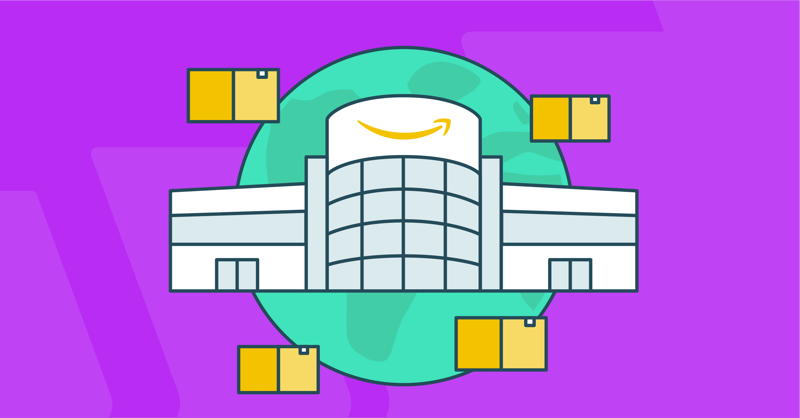
Over 90% of top sellers on Amazon use FBA, Fulfillment by Amazon. After all, FBA offers access to one of the most advanced fulfillment networks in the world—and it’s tied to the coveted Prime badge and two-day shipping turn-around. But the past few years have been a rollercoaster for both Amazon and FBA sellers, as Amazon continues to face supply chain and labor challenges, as FBA fees, restock limitations, and storage restrictions continue to fluctuate, and as macroeconomic concerns continue to impact consumer spend.
In September 2022, during Amazon Accelerate (their premier annual seller conference), the giant revealed they've been working on a storage solution to give sellers a lower cost way of managing bulk inventory before it hits FBA warehouses: Amazon Warehousing & Distribution, AWD. Over the past few months, SupplyKick’s logistics team has unpacked the ins and outs of the new program and what this means for 3P sellers, FBA inventory forecasting, important shipping timelines, and more.
Read this article for:
Launched by Amazon in 2022, AWD is a 3PL and bulk storage solution offered by Amazon for third-party marketplace sellers. As described by Amazon: “Amazon Warehousing & Distribution (AWD) is a new third-party logistics (3PL) solution offered by Amazon Supply Chain. AWD provides flexible and low-cost upstream bulk inventory storage and distribution for your business.”
AWD seeks to specifically help brands who are experiencing issues with FBA storage limits and stockouts. The long-term inventory storage solution allows FBA sellers to avoid stockouts and auto-replenish inventory directly into Amazon Fulfillment Centers/the Amazon Fulfillment Network.
As highlighted by Amazon, AWD’s top features include:
So you may be wondering, “Is AWD something I should seriously consider?” From SupplyKick’s perspective, AWD in its current state could possibly work for you if:
| You’re an FBA seller with Standard Size items who ships Less-Than-Truckload (LTL), looking for a bulk Amazon inventory storage solution | |
| You’re an international brand with Standard Size items who ships LTL, looking for a U.S.-based bulk storage solution |
Here’s a list of benefits and limitations we’ve identified within the Amazon Warehousing & Distribution program so far:
As previously mentioned, AWD provides a long-term bulk storage solution that empowers sellers to automatically position their inventory in Amazon FCs. Before you decide to ship to AWD, be sure to review the pros and cons listed above, as well as the following Amazon guidelines:
Once accepted into the program, here is the standard process for sending in inventory to AWD. Amazon recommends sending in a small test shipment when starting the program:
| Seller sends in eligible SKUs (via LTL) to AWD using their own carrier. | |
| Amazon holds the inventory in AWD and, using their algorithm, automatically replenishes inventory into their FBA Fulfillments Centers when levels get low. | |
| Seller has the ability to see automated replenishment orders and can track their inventory levels at AWD within their Seller Central account. | |
| When necessary, the seller sends in more inventory to AWD. |
How much do AWD storage fees cost? Compared to FBA, AWD storage fees are much lower than typical FBA fees, but all AWD inventory also incurs processing and transportation fees, so it’s important to do a cost analysis to see if AWD is an efficient solution for your business as an Amazon wholesale seller.
The following fees are applied to AWD inventory:
Below is Amazon’s rate card as of August 1, 2022:
| Amazon's Rate Card (as of August 1, 2022) |
| AWD Fee Type | Rate |
| Storage | Non-holiday (Jan-Sept): $0.42 per cubic foot Holiday season (Oct-Dec): $0.80 per cubic foot |
| Processing | $2.00 per case |
| Transportation | $1.00 per cubic foot |
In addition to expanding their Buy with Prime program, Amazon continues to refine logistics and features for Amazon Warehousing and Distribution. This solution is still very much in its infancy, so SupplyKick will continue to update this post with future AWD program additions or changes.
There are a few AWD features Amazon has mentioned that are in development for 2023. Here’s what we most look forward to becoming a reality within the next year:
From inventory management to listing optimization services, keeping up with marketplace changes, competitors, and new programs is a full-time job. If you’re looking for Amazon consultancy services or a trusted Amazon wholesale seller to help tackle it all (while saving you time, resources, and a lot less stress), connect with our team.
Lorem ipsum dolor sit amet, consectetur adipiscing elit


Sign up to receive our newsletter for growth strategies, important updates, inventory and policy changes, and best practices.
These Stories on Logistics & Fulfillment
For press inquiries, please contact Molly Horstmann, mhorstmann@supplykick.com